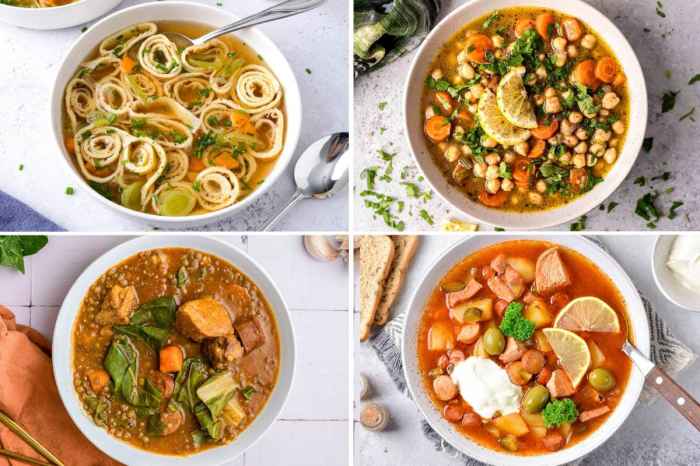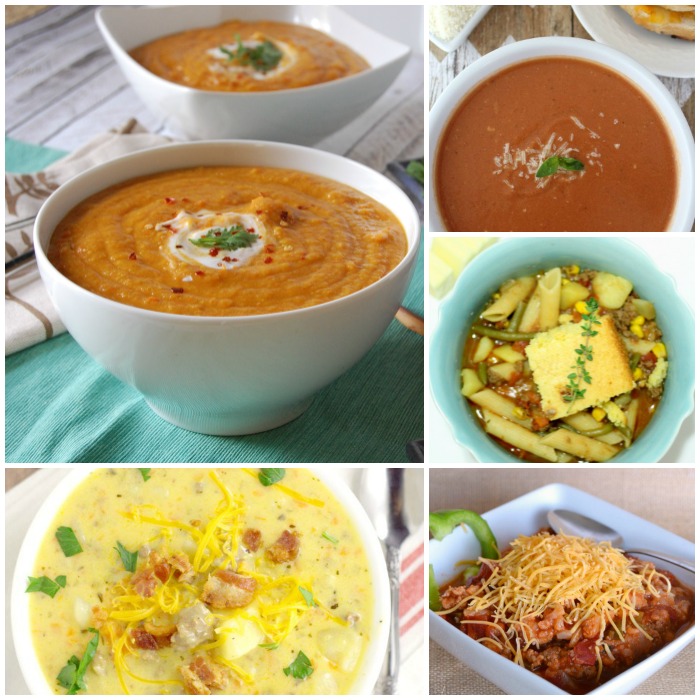Delish Soup Recipe Variety
Soup recipes delish – This section explores a diverse range of ten soup recipes, categorized by cuisine, highlighting their unique flavor profiles and key ingredients. Each soup offers a distinct culinary experience, showcasing the versatility and global appeal of this comforting dish.
Delicious soup recipes are incredibly versatile, offering a wide range of flavors and textures. For those seeking a healthier approach, incorporating cleansing elements is easy; you might consider exploring some fantastic options like those found in this collection of soup detox recipes to boost your well-being. Returning to the broader world of soup recipes delish, remember that even the simplest recipes can be elevated with fresh herbs and a touch of creativity.
Diverse Soup Recipes
- Italian Minestrone: A hearty vegetable soup featuring pasta, beans, and seasonal vegetables. Its flavor profile is rich and savory, with a hint of acidity from tomatoes.
- French Onion Soup: Caramelized onions simmered in beef broth, topped with toasted baguette and Gruyère cheese. The flavor is deeply sweet and savory, with a rich, umami depth.
- Thai Tom Yum Soup: A spicy and sour soup with lemongrass, galangal, kaffir lime leaves, and chili peppers. The flavor is vibrant and complex, balancing sweet, sour, spicy, and savory notes.
- Japanese Miso Soup: A simple yet flavorful soup made with miso paste, seaweed, and tofu. Its flavor is umami-rich and subtly salty, with a delicate balance of flavors.
- Mexican Tortilla Soup: A flavorful soup with a rich tomato broth, shredded chicken or vegetables, tortilla strips, and avocado. Its flavor profile is savory and slightly spicy, with a creamy texture from the avocado.
- American Chicken Noodle Soup: A classic comfort food featuring chicken broth, noodles, and vegetables. Its flavor is savory and comforting, with a mild and familiar taste.
- Indian Mulligatawny Soup: A creamy curry soup with chicken or vegetables, lentils, and aromatic spices. Its flavor is rich and complex, with a blend of savory, spicy, and tangy notes.
- Greek Avgolemono Soup: A lemony chicken soup thickened with a mixture of eggs and lemon juice. Its flavor is bright and tangy, with a creamy texture and subtle chicken flavor.
- Moroccan Harira Soup: A hearty tomato-based soup with lentils, chickpeas, and spices. Its flavor is rich and complex, with a blend of sweet, savory, and spicy notes.
- Brazilian Caldo Verde: A Portuguese-Brazilian soup made with potatoes, kale, and chorizo. Its flavor is savory and earthy, with a slight smoky note from the chorizo.
Soup Recipe Summary Table

Source: recipesfromeurope.com
| Soup Name | Cuisine | Primary Ingredients | Description |
|---|---|---|---|
| Minestrone | Italian | Pasta, beans, vegetables | Hearty vegetable soup with pasta and beans. |
| French Onion Soup | French | Caramelized onions, beef broth | Sweet and savory soup with toasted bread and cheese. |
| Tom Yum Soup | Thai | Lemongrass, galangal, chili | Spicy and sour soup with aromatic herbs. |
| Miso Soup | Japanese | Miso paste, seaweed, tofu | Simple and flavorful soup with umami notes. |
| Tortilla Soup | Mexican | Tomato broth, chicken, tortilla strips | Savory and slightly spicy soup with avocado. |
| Chicken Noodle Soup | American | Chicken broth, noodles, vegetables | Classic comfort food with a mild flavor. |
| Mulligatawny Soup | Indian | Chicken/vegetables, lentils, spices | Rich and complex curry soup. |
| Avgolemono Soup | Greek | Chicken broth, eggs, lemon juice | Bright and tangy soup with creamy texture. |
| Harira Soup | Moroccan | Tomatoes, lentils, chickpeas, spices | Hearty tomato-based soup with complex flavors. |
| Caldo Verde | Brazilian | Potatoes, kale, chorizo | Savory and earthy soup with smoky chorizo. |
Recipe Difficulty Levels and Time Commitment
The difficulty of each recipe is assessed based on the number of steps, the complexity of techniques involved, and the availability of ingredients. Time commitment includes both preparation and cooking time.
- Easiest (15-30 minutes total): Miso Soup (simple ingredients, quick cooking time).
- Easy (30-45 minutes total): Chicken Noodle Soup (familiar ingredients, straightforward steps).
- Medium (45-60 minutes total): Tortilla Soup (moderate prep, simple cooking).
- Medium (60-75 minutes total): Minestrone (multiple ingredients, longer simmering time).
- Medium-Hard (75-90 minutes total): Avgolemono Soup (technique-sensitive egg and lemon thickening).
- Hard (90-120 minutes total): French Onion Soup (long caramelization process).
- Hard (120-150 minutes total): Mulligatawny Soup (multiple spices, precise flavor balancing).
- Hardest (150+ minutes total): Harira Soup (multiple ingredients, long simmering time).
- Hardest (150+ minutes total): Caldo Verde (requires specific sausage and careful kale preparation).
- Hardest (150+ minutes total): Tom Yum Soup (precise balance of sour, spicy, and savory flavors).
Visual Representation of Difficulty: Imagine a ladder with five rungs. The easiest recipes are at the bottom rung, represented by a single, simple block. As the difficulty increases, the blocks become more complex, with additional elements added to each rung, culminating in a complex, multi-layered structure at the top rung representing the hardest recipes. The time commitment is visually represented by the size of each block, with larger blocks indicating longer preparation and cooking times.
Ingredient Sourcing and Substitutions
This section details the availability and seasonality of key ingredients, and provides substitution options for enhanced flexibility.
Many ingredients are readily available year-round in supermarkets. However, seasonal ingredients, such as certain vegetables, can significantly enhance the flavor of the soups. For example, using fresh, seasonal tomatoes in Minestrone will provide a superior taste compared to using canned tomatoes. Similarly, using fresh herbs will generally yield better results.
| Original Ingredient | Potential Substitutes | Impact on Flavor |
|---|---|---|
| Chicken Broth (Chicken Noodle Soup) | Vegetable broth, bone broth | Vegetable broth will yield a lighter flavor; bone broth will add richness. |
| Caramelized Onions (French Onion Soup) | Shallots, leeks | Shallots offer a milder sweetness; leeks add a more pungent flavor. |
| Miso Paste (Miso Soup) | Soy sauce (reduced amount), nutritional yeast | Soy sauce will provide saltiness but less umami; nutritional yeast offers a cheesy, umami note. |
| Tomatoes (Minestrone) | Tomato paste, sun-dried tomatoes | Tomato paste provides a more concentrated flavor; sun-dried tomatoes add a deeper, sweeter flavor. |
| Chicken (Mulligatawny Soup) | Tofu, lentils | Tofu offers a neutral flavor; lentils add a hearty texture and earthiness. |
Serving Suggestions and Pairings, Soup recipes delish

Source: tasteofhome.com
Creative serving suggestions and ideal pairings enhance the overall dining experience.
- Minestrone: Serve with crusty bread and a side salad. Garnish with grated Parmesan cheese and fresh basil.
- French Onion Soup: Serve in oven-safe bowls for a dramatic presentation. Pair with a simple green salad.
- Tom Yum Soup: Serve with steamed rice and fresh cilantro. Garnish with lime wedges.
- Miso Soup: Serve in small bowls as a starter. Pair with sushi or other Japanese dishes.
- Tortilla Soup: Serve with a dollop of sour cream or crema fresca. Garnish with avocado and tortilla strips.
- Chicken Noodle Soup: Serve with crusty bread or crackers. Garnish with fresh parsley.
- Mulligatawny Soup: Serve with naan bread or rice. Garnish with fresh cilantro.
- Avgolemono Soup: Serve warm with a side of pita bread. Garnish with fresh dill.
- Harira Soup: Serve with dates and crusty bread. Garnish with fresh cilantro.
- Caldo Verde: Serve with crusty bread. Garnish with chopped parsley.
Plating: For an attractive presentation, consider using bowls that complement the soup’s color and style. Garnishes should be added thoughtfully, creating visual appeal without overwhelming the soup’s presentation. A simple swirl of cream or a sprinkle of herbs can elevate the visual appeal.
Dietary Adaptations

Source: onecrazyhouse.com
This section details how to adapt recipes to accommodate various dietary needs.
- Minestrone (Vegetarian/Vegan): Omit the meat broth and use vegetable broth instead. Add extra vegetables for a heartier texture.
- Chicken Noodle Soup (Vegetarian/Vegan): Substitute chicken broth with vegetable broth. Use mushrooms or other vegetables to add depth of flavor.
- Mulligatawny Soup (Vegetarian/Vegan): Omit the chicken and use vegetable broth. Add extra lentils or chickpeas for protein.
- Avgolemono Soup (Vegetarian/Gluten-Free): Ensure that the chicken broth used is gluten-free. The original recipe is naturally gluten-free.
- Tortilla Soup (Gluten-Free): Use gluten-free tortilla chips as a garnish.
Nutritional Comparison: Vegetarian and vegan adaptations generally result in lower fat and cholesterol content, with higher fiber content. Gluten-free adaptations do not significantly alter the nutritional profile unless specific gluten-containing ingredients are replaced with alternatives that differ significantly in nutritional value.
Recipe Scaling and Storage
This section provides guidance on scaling recipes and storing leftovers.
Most recipes can be easily scaled up or down by adjusting the ingredient quantities proportionally. For example, to double a recipe, simply double the amount of each ingredient. To halve a recipe, halve the amount of each ingredient.
Leftovers should be stored in airtight containers in the refrigerator for up to 3-4 days. Soups can also be frozen for longer storage. Allow the soup to cool completely before freezing. Thaw frozen soup in the refrigerator overnight before reheating. Reheating should be done gently to avoid scorching or altering the texture.
Step-by-Step Recipe Breakdown: Miso Soup
This section provides a detailed, step-by-step guide for preparing Miso Soup.
- Prepare Ingredients: Gather all ingredients: miso paste, dashi (or vegetable broth), tofu (optional), seaweed (optional), green onions (optional).
- Heat Broth: Gently heat the dashi (or vegetable broth) in a saucepan over medium-low heat. Do not boil.
- Add Tofu (Optional): If using tofu, cube it and add it to the broth during the last few minutes of heating.
- Add Seaweed (Optional): If using seaweed, add it to the broth during the last few minutes of heating.
- Dissolve Miso Paste: In a separate bowl, whisk a small amount of the hot broth into the miso paste to create a smooth paste. This prevents the miso from clumping.
- Combine: Slowly pour the miso mixture into the saucepan, stirring gently to combine. Do not boil.
- Serve: Ladle the soup into bowls. Garnish with chopped green onions, if desired.
Visual Representation: Imagine a series of simple illustrations. The first shows the ingredients laid out. The second depicts the broth gently heating. The third shows the tofu (if used) being added. The fourth shows the seaweed (if used) being added.
The fifth shows the miso paste being whisked with a small amount of broth. The sixth shows the miso mixture being added to the saucepan. The seventh shows the finished soup being ladled into bowls, garnished with green onions.
Popular Questions: Soup Recipes Delish
Can I use frozen vegetables in these recipes?
Yes, frozen vegetables can often be substituted for fresh, but be mindful that they may release more water during cooking. Adjust cooking time accordingly.
How long can I store leftover soup?
Most soups can be stored in the refrigerator for 3-5 days. Always allow the soup to cool completely before refrigerating.
What’s the best way to reheat soup?
Reheat soup gently on the stovetop or in the microwave, stirring occasionally to prevent scorching. Avoid boiling.
Can I make these recipes in a slow cooker?
Many of these recipes can be adapted for slow cooking. Adjust cooking times as needed, and be mindful of potential liquid evaporation.
